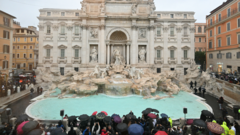The iconic Trevi Fountain in Rome has officially reopened to the public after undergoing a substantial three-month restoration. This masterpiece, designed in the 18th Century by the esteemed architect Nicola Salvi, is renowned as one of the city's top tourist attractions. Previously, the fountain welcomed an average of 10,000 to 12,000 visitors daily, raising concerns about overly large crowds.
Rome's Mayor, Roberto Gualtieri, announced on Sunday that a new queuing system will be implemented to maintain order and improve the visitor experience, saying it will "allow everyone to better enjoy the fountain, without crowds or confusion." In addition to the queuing system, the city is also contemplating the introduction of a nominal entry fee to help fund ongoing maintenance of this historical site.
Despite light rain during the reopening ceremony, hundreds of tourists gathered, many of whom participated in the traditional act of tossing coins into the fountain, which symbolizes making a wish. The restoration project involved extensive cleaning efforts to eliminate mould and calcium buildup, preparing the fountain and other significant locations in Rome for the upcoming jubilee of the Roman Catholic Church, commencing on Christmas Eve.
This renovation is particularly significant considering the fountain's deteriorating condition highlighted in 2012, when pieces of its decorative cornice fell due to a harsh winter, prompting a much-needed multi-million euro renovation. Historically, the tradition of throwing coins into the Trevi Fountain has garnered significant charity contributions—around €10,000 each week—proceeds from which support local initiatives to provide meals to the needy.
Acclaimed not just for its beauty but also for its cultural significance, the Trevi Fountain marks the terminus of one of the ancient aqueducts that supplied Rome with water. The fountain, fed by the Acqua Vergine that stretches 20 kilometers, has its origins linked to a legend from 19 BC involving thirsty Roman soldiers and a young virgin, yielding its name "Virgin Waters." The site's fame was further popularized by Frank Sinatra's song, "Three Coins in the Fountain."
Rome's Mayor, Roberto Gualtieri, announced on Sunday that a new queuing system will be implemented to maintain order and improve the visitor experience, saying it will "allow everyone to better enjoy the fountain, without crowds or confusion." In addition to the queuing system, the city is also contemplating the introduction of a nominal entry fee to help fund ongoing maintenance of this historical site.
Despite light rain during the reopening ceremony, hundreds of tourists gathered, many of whom participated in the traditional act of tossing coins into the fountain, which symbolizes making a wish. The restoration project involved extensive cleaning efforts to eliminate mould and calcium buildup, preparing the fountain and other significant locations in Rome for the upcoming jubilee of the Roman Catholic Church, commencing on Christmas Eve.
This renovation is particularly significant considering the fountain's deteriorating condition highlighted in 2012, when pieces of its decorative cornice fell due to a harsh winter, prompting a much-needed multi-million euro renovation. Historically, the tradition of throwing coins into the Trevi Fountain has garnered significant charity contributions—around €10,000 each week—proceeds from which support local initiatives to provide meals to the needy.
Acclaimed not just for its beauty but also for its cultural significance, the Trevi Fountain marks the terminus of one of the ancient aqueducts that supplied Rome with water. The fountain, fed by the Acqua Vergine that stretches 20 kilometers, has its origins linked to a legend from 19 BC involving thirsty Roman soldiers and a young virgin, yielding its name "Virgin Waters." The site's fame was further popularized by Frank Sinatra's song, "Three Coins in the Fountain."






















